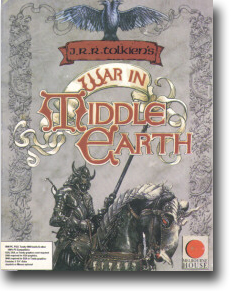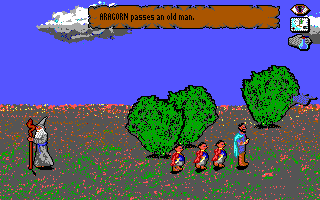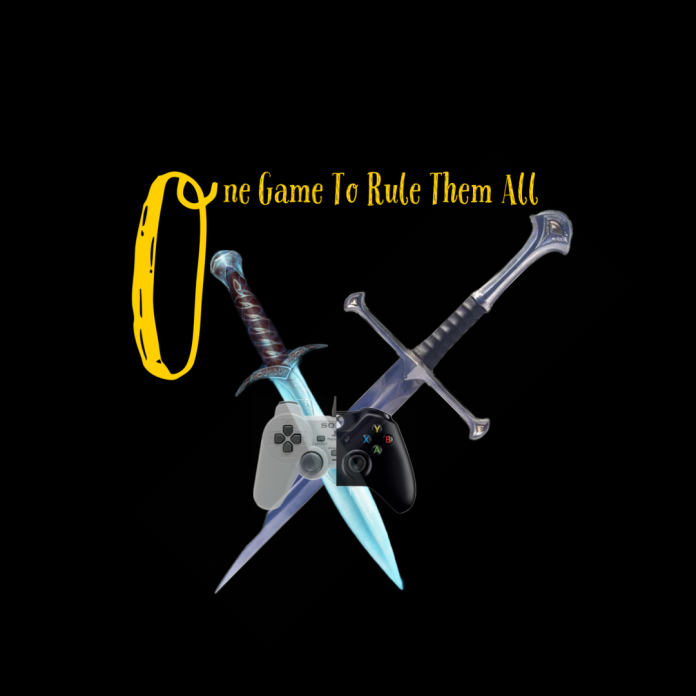The next game in this series is War in Middle-Earth which is a classic real-time strategy (RTS) game that was first released in 1988 for various platforms, including the Commodore 64, ZX Spectrum, and Amstrad CPC. Developed by Synergistic Software and published by Melbourne House, the game aimed to bring J.R.R. Tolkien’s epic fantasy world to life in a strategic war simulation.
War in Middle-Earth-1988

Gameplay and Graphics
The gameplay of War in Middle-Earth revolves around managing the armies of the Free Peoples of Middle-Earth, including the iconic characters like Frodo, Aragorn, and Gandalf, as they strive to thwart Sauron’s advances. The game combines elements of both strategy and role-playing, allowing players to control armies in large-scale battles and guide the Fellowship on their perilous journey.
Players navigate through a detailed map of Middle Earth, encountering various locations and engaging in battles with Sauron’s forces. The strategic aspect involves resource management, army recruitment, and the overall coordination of military campaigns. The role-playing element comes into play during key story events, where players control individual characters to make decisions and face challenges.
Given the technological constraints of the late 1980s, the graphics of War in Middle-Earth are very basic by today’s standards. The game utilises sprite-based visuals, and while the character representations are recognisable, the overall aesthetic lacks the level of detail and sophistication seen in more modern titles.
The sound design is minimal, with simple tunes and sound effects that were common in games of that era. While the limitations of technology at the time are understandable, it’s worth noting that the audio and visuals may feel outdated for contemporary players.

Story and Faithfulness to the Source Material
War in Middle Earth attempts to faithfully adapt J.R.R. Tolkien’s expansive Middle-earth legendarium, encompassing events from both The Hobbit and The Lord of the Rings, the game follows the chronology of the books, offering a narrative-driven experience that aligns with the source material.
The inclusion of key characters and locations from Tolkien’s works is a strong point, allowing players to immerse themselves in the rich lore of Middle-Earth. However, due to the technical limitations of the time, the game necessarily takes liberties with the representation of the story, and the depth of narrative engagement may not match the experience of reading the books.
Reception
War in Middle-Earth received mixed reviews upon its release. While praised for its ambitious attempt to bring Tolkien’s world to the gaming realm, the game faced criticism for its clunky interface, limited graphics, and the challenge of navigating the large game world.
The legacy of War in Middle Earth lies in its role as one of the early attempts to adapt high fantasy literature into a video game format. It set a precedent for subsequent games exploring Middle-Earth, paving the way for more sophisticated adaptations in the years to come. Despite its limitations, the game is remembered fondly by fans of both Tolkien and classic gaming.
War in Middle Earth holds a significant place in the history of video game adaptations of literary works. While its limitations in graphics and gameplay mechanics may make it less accessible to contemporary audiences, it remains a noteworthy title for those interested in exploring the early attempts to translate the intricate narratives of J.R.R. Tolkien into an interactive gaming experience. As technology advanced, subsequent adaptations would build upon the foundation laid by “War in Middle Earth,” offering more refined and immersive journeys into the beloved realms of Middle-Earth.
One Ring Rating – 3+ out of 5
Check back here next Thursday for the next game in the series JRR Tolkiens Lord of the Rings-1990.










